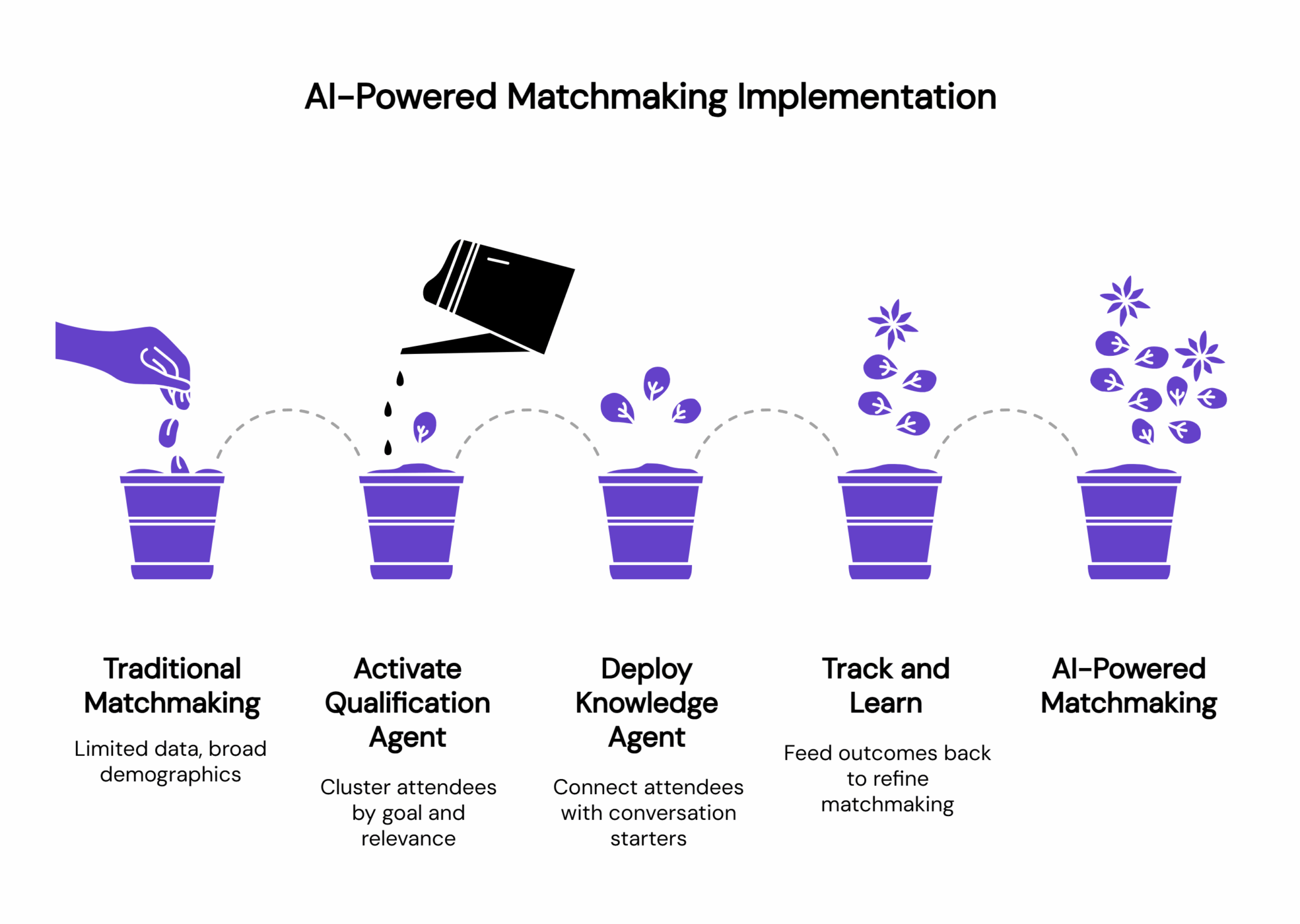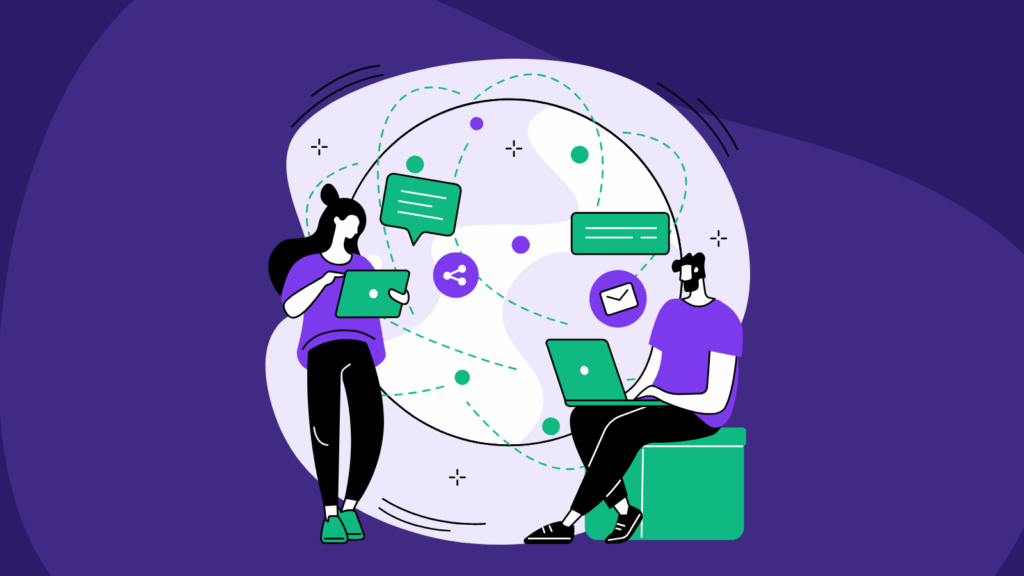Every event promises networking gold, the kind of serendipity where you bump into the perfect contact over coffee and it somehow changes your quarter. But anyone who’s walked out of a conference with a bag full of business cards and no follow-ups knows how rare that is. Most matchmaking is still broken.
Despite all the apps, tags, and filters, attendees meet too many people they’ll never speak to again, and somehow miss the ones who could actually move the needle. What’s missing is a smarter way to turn those chance meetings into real connections.
Why traditional matchmaking falls short
Traditional event matchmaking is built on wishful thinking. Attendees fill out a few tags (“AI”, “Marketing”, “Partnerships”), and software pairs them up with others who picked the same. It’s convenient, but completely shallow.
No wonder so many attendees leave disappointed. According to Bizzabo’s State of Events report, only 46% of organizers believe their current networking opportunities truly help attendees build meaningful connections. If the hosts themselves aren’t confident, it’s easy to see why attendees often walk away thinking, “Well, maybe next year.”
Here’s the issue:
- Matches are generic or based on self-declared interests that rarely get updated.
- Most attendees ignore matchmaking suggestions entirely, leaving potential connections unmade
- Exhibitors scan badges but can’t tell who’s genuinely interested.
- Organizers see numbers, not relationships.
So what was meant to be a curated experience ends up feeling random.
The business impact is significant. When matchmaking fails, sponsors and exhibitors don’t see ROI. They meet the wrong people, waste time on unqualified leads, and question whether the event was worth it. Our data across 500+ events shows that poor matchmaking directly impacts the bottom line: sponsors are less likely to renew, and overall event revenue suffers.
Better matchmaking changes this equation. When connections improve, sponsors see real value. They book more targeted meetings, host successful side events, and come back year after year. The numbers bear this out: effective matchmaking can drive up to 40% additional spend from sponsors and exhibitors, measured through metrics like targeted meeting revenue and renewal rates.
Every event already has the data needed to fix it, they’re just not using it.
The Opportunity: There’s more data than you think
Events generate oceans of behavioral data that most matchmaking tools simply ignore.
Every session joined, every question asked, every booth visited tells a story about what that person actually cares about.
Consider what’s hiding in plain sight:
- Session attendance and dwell time → reveals topical interest
- App usage and bookmarks → show what’s being researched
- Questions asked → show pain points and goals
- Booth visits, QR scans, downloads → show buying intent
This is intent data. It’s the difference between “interested in marketing” and “searching for AI-driven personalization tools.”
The opportunity is to use the data we already have to create matches that make sense.
The Fix: From Static Matching to Agentic Matchmaking

Many think AI is here to replace networking. It’s not. It’s here to make networking worth your time.
We’re witnessing a fundamental shift in how matchmaking works at events. Instead of relying on static tags and one-time suggestions, agentic matchmaking uses AI agents that observe, learn, and adapt throughout the entire event.
Current Matchmaking vs. Agentic Matchmaking
How current systems work:
- Attendees manually select interest tags at registration
- System matches based on overlapping tags
- Connections are suggested once, then forgotten
- No learning, no adaptation, no context
How agentic matchmaking works:
- AI agents observe actual behavior throughout the event
- They identify intent based on what people do, not just what they say
- Matches evolve in real-time as new signals emerge
- Agents proactively facilitate conversations at the right moment
Think of it this way: current matchmaking is like speed dating based on dating profiles. Agentic matchmaking is like having a perceptive friend at the party who knows exactly who you should meet and introduces you at just the right moment.
How Bridged Makes Agentic Matchmaking Possible
This approach requires two types of intelligent agents working together:
- The Qualification Agent: Your Smart Matchmaker
Bridged’s Qualification Agent scans attendee data across registration forms, session participation, content engagement, and CRM touchpoints. It uses small, domain-trained language models, not generic AI, to qualify attendees by interest, goals, and potential fit.It pairs someone exploring AI-driven CRM tools with an exhibitor offering exactly that. You can think of it as matchmaking powered by intent.
- The Knowledge Agent: The Instant Connector
The Knowledge Agent takes the baton. Once the right matches are identified, it helps spark conversations. Instead of emails lost in inboxes, it enables real-time outreach where people already are.That could mean:
-
- A WhatsApp nudge from an exhibitor: “Hey, saw you attended our AI in Marketing talk, we’re at Booth 42 if you’d like to continue the discussion.”
- A gentle reminder from the event app: “Sophie from Brand X is nearby, you both bookmarked the same session on automation.”
The Knowledge Agent turns static matches into living conversations.
The result: Building real relationships beyond random scans
With AI-powered matchmaking, everyone wins.
For Attendees:
You meet fewer people, but all of them matter. Conversations feel natural because they’re rooted in shared goals or interests.
For Exhibitors:
You spend less time chasing irrelevant leads. Every meeting has higher intent.
For Sponsors and Organizers:
You see better booth footfall, stronger meeting rates, and happier attendees.
And when connections improve, so does everything else, NPS, retention, and sponsorship renewals.
Here’s how to implement it: Qualification and Knowledge Agent in action

Implementing AI-powered matchmaking doesn’t require a major overhaul, but a slight shift in how data is used.
Step 1: Activate the Qualification Agent
Plug in your event registration, CRM, and behavioral data. The agent clusters attendees by goal and relevance, not just demographics.
Example: Instead of “Marketers from the US,” you get “B2B marketers researching AI content tools.”
Step 2: Deploy the Knowledge Agent
Once matched, use the Knowledge Agent to connect instantly via WhatsApp, chat, or app notifications. Send conversation starters tied to real behavior:
“Noticed you attended the Growth Automation panel, would love to show you how we’ve built similar workflows.”
Step 3: Track and Learn
Feed outcomes back to the system, who replied, who met, who converted. The agents learn and refine future matchmaking automatically. The more you use it, the sharper it gets.
The possibilities are limitless, here are some
- At TechBBQ 2021 in Copenhagen, the largest startup and innovation summit in Scandinavia, used AI matchmaking to facilitate 2,800 one-on-one meetings with a 39% meeting acceptance rate. By opening their networking platform two weeks before the conference, attendees could connect and book meetings in advance, ensuring everyone walked in with a clear agenda.
- Wolves Summit 2021 in Warsaw took a similar approach for their hybrid event. The premier networking conference for European startups, investors, and corporations facilitated over 2,200 meetings with a 34% acceptance rate. For startups seeking funding, this kind of targeted matching proved invaluable in connecting them with the right investors.
- LendIt Fintech, the largest media and events company in lending and digital banking, has taken this even further. Across 13 virtual events, they’ve secured over 22,000 one-on-one meetings with an average 31% acceptance rate, contributing to exponential growth in their Net Promoter Score. Source
The pattern is clear: when matchmaking shifts from random to intentional, meeting quality improves, acceptance rates climb, and attendee satisfaction follows.
The future of event matchmaking
The goal of event networking has never been “more meetings.” It’s “better meetings.” AI simply makes that possible at scale.
With the right combination of data and automation, matchmaking can evolve from a random checkbox feature to the centerpiece of attendee experience. Now, it’s about designing events where the default outcome is that you get good meetings.
And when AI starts connecting the dots, the next handshake might actually be the one that matters.
Continue reading
Lastly, if you liked this blog, you will also like
- Publisher playbook: 3 steps to kickstart your AI strategy on a shoestring
- How to Make Virtual Attendees Feel Seen in Hybrid Events
- Collecting customers: how media companies can boost email subscriptions with AI
FAQs
- What does AI matchmaking mean?
AI matchmaking uses both declared and behavioral data to recommend relevant connections between attendees, exhibitors, and sponsors. It’s designed to surface matches that share genuine intent or goals. - Why is traditional matchmaking ineffective?
Most systems depend on static tags or manual inputs, which quickly become outdated or too broad. They ignore behavioral context, what people actually do during the event. - How does a Qualification Agent help?
It analyzes multiple data sources (like session attendance, engagement, and registrations) to automatically identify who’s most relevant to whom, helping prioritize meaningful matches. - What role does a Knowledge Agent play?
It bridges the gap between a good match and an actual conversation. By reaching out instantly through chat or WhatsApp, it ensures timing and context are right for engagement. - What kind of outcomes can event teams expect?
Event teams often report higher booth visits, more qualified meetings, and improved attendee satisfaction. Some platforms, like Brella, note up to 18% increases in attendee retention with intent-based matchmaking, showing clear, data-backed impact. - Does AI matchmaking replace human networking?
No, it enhances it. AI doesn’t decide who to talk to; it simply brings the right people together at the right time so that conversations can start more naturally.


